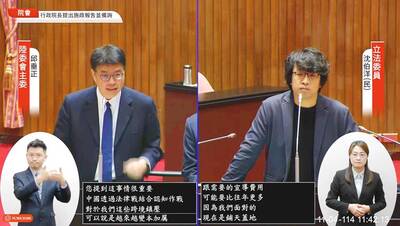Defense officials should address flaws in the military observed by US officials, Democratic Progressive Party (DPP) Legislator Wang Ting-yu (王定宇) said yesterday, after the Financial Times reported that a “low-key” delegation visited Taipei last month to assess the nation’s forces and the potential for closer cooperation.
The visiting US advisers found the Taiwanese military proficient at a tactical level, but lacking the ability to think strategically, the report said.
However, they assessed efforts to be on the right track.

Photo courtesy of the 8th Field Army
President Tsai Ing-wen (蔡英文) “has made the difficult and big move to tell the public things need to change and an all-of-society effort is needed to defend their homeland,” the Financial Times quoted a US official as saying. “There will be more progress from here.”
The report suggests that US-Taiwan joint military training and exchange programs are becoming more “open and normalized” with improving bilateral ties, Wang said.
Although Taiwan’s long-term national defense strategy emphasizing deep strikes and multilayered deterrence was adequate, the US delegates observed shortfalls in some capabilities, he said.
Citing an example, he said the armed forces were assessed as utilizing an obsolete model of command and control that needs to be flatter and more distributed, he added.
The armed forces should think about a strategy for maintaining the nation’s military edge, as China’s People’s Liberation Army has revamped its amphibious and airborne assault capabilities, Wang said.
An effective response would require new strategic concepts and military cooperation programs, he said, adding that the Ministry of National Defense and other national security agencies should take heed of the delegation’s assessment.
Meanwhile, a source familiar with the matter said that the defense ministry is mulling sending a military delegation to observe the US National Guard for reference in managing and instilling combat effectiveness in Taiwan’s reserve force.
Since Taiwan and the US inked a coast guard memorandum of understanding, bilateral cooperation in military and paramilitary affairs has surged to encompass training, tactics and combat skills, they said, describing the relationship as “present and ongoing.”
Taiwan sends many service members for training in the US, including F-16 pilots and regular army personnel, while special forces and marines are also involved, they said.
The All-Out Defense Mobilization Agency’s decision to appoint a colonel-rank liaison officer to head Taiwan reserve force-US national guard cooperation shows the program has become normalized, said Su Tzu-yun (蘇紫雲), a research fellow at the Institute of National Defense and Security Research.
Taiwan’s reserve force could benefit from collaborating with the US national guard and learning from the latter’s training, institution and culture, he said, adding that the two forces have similar responsibilities of territorial defense and disaster response.

CALL FOR SUPPORT: President William Lai called on lawmakers across party lines to ensure the livelihood of Taiwanese and that national security is protected President William Lai (賴清德) yesterday called for bipartisan support for Taiwan’s investment in self-defense capabilities at the christening and launch of two coast guard vessels at CSBC Corp, Taiwan’s (台灣國際造船) shipyard in Kaohsiung. The Taipei (台北) is the fourth and final ship of the Chiayi-class offshore patrol vessels, and the Siraya (西拉雅) is the Coast Guard Administration’s (CGA) first-ever ocean patrol vessel, the government said. The Taipei is the fourth and final ship of the Chiayi-class offshore patrol vessels with a displacement of about 4,000 tonnes, Lai said. This ship class was ordered as a result of former president Tsai Ing-wen’s (蔡英文) 2018

‘SECRETS’: While saying China would not attack during his presidency, Donald Trump declined to say how Washington would respond if Beijing were to take military action US President Donald Trump said that China would not take military action against Taiwan while he is president, as the Chinese leaders “know the consequences.” Trump made the statement during an interview on CBS’ 60 Minutes program that aired on Sunday, a few days after his meeting with Chinese President Xi Jinping (習近平) in South Korea. “He [Xi] has openly said, and his people have openly said at meetings, ‘we would never do anything while President Trump is president,’ because they know the consequences,” Trump said in the interview. However, he repeatedly declined to say exactly how Washington would respond in

WARFARE: All sectors of society should recognize, unite, and collectively resist and condemn Beijing’s cross-border suppression, MAC Minister Chiu Chui-cheng said The number of Taiwanese detained because of legal affairs by Chinese authorities has tripled this year, as Beijing intensified its intimidation and division of Taiwanese by combining lawfare and cognitive warfare, the Mainland Affairs Council (MAC) said yesterday. MAC Minister Chiu Chui-cheng (邱垂正) made the statement in response to questions by Democratic Progressive Party (DPP) Legislator Puma Shen (沈柏洋) about the government’s response to counter Chinese public opinion warfare, lawfare and psychological warfare. Shen said he is also being investigated by China for promoting “Taiwanese independence.” He was referring to a report published on Tuesday last week by China’s state-run Xinhua news agency,

‘ADDITIONAL CONDITION’: Taiwan will work with like-minded countries to protect its right to participate in next year’s meeting, the foreign ministry said The US will “continue to press China for security arrangements and protocols that safeguard all participants when attending APEC meetings in China,” a US Department of State spokesperson said yesterday, after Beijing suggested that members must adhere to its “one China principle” to participate. “The United States insists on the full and equal participation of all APEC member economies — including Taiwan — consistent with APEC’s guidelines, rules and established practice, as affirmed by China in its offer to host in 2026,” the unnamed spokesperson said in response to media queries about China putting a “one China” principle condition on Taiwan’s